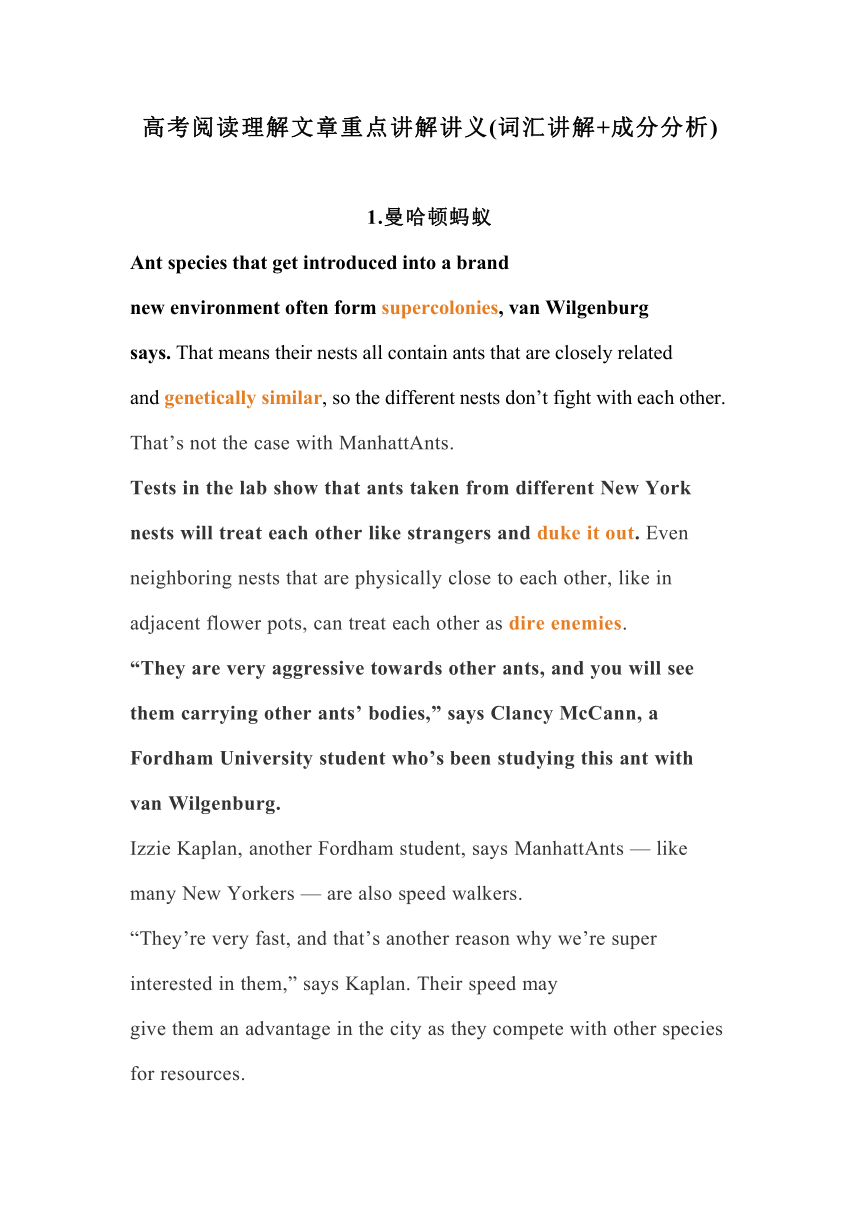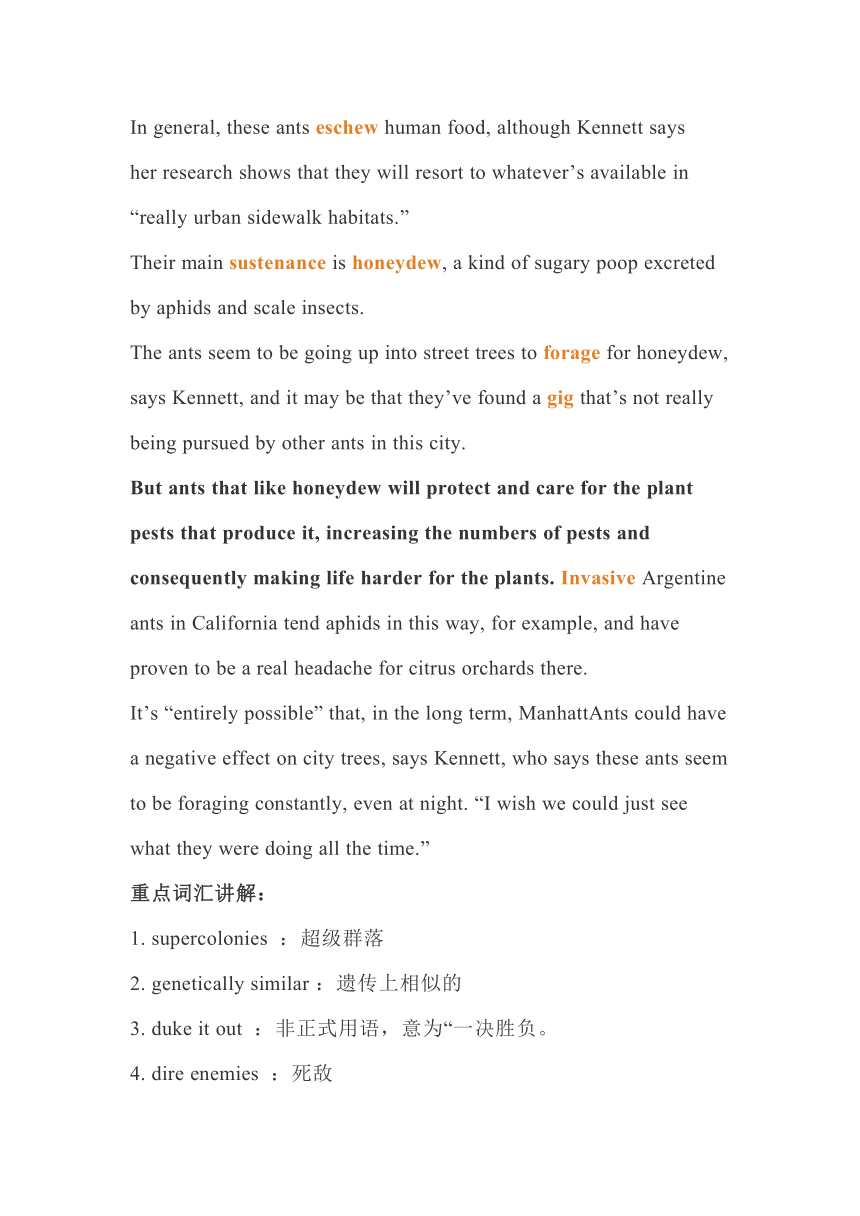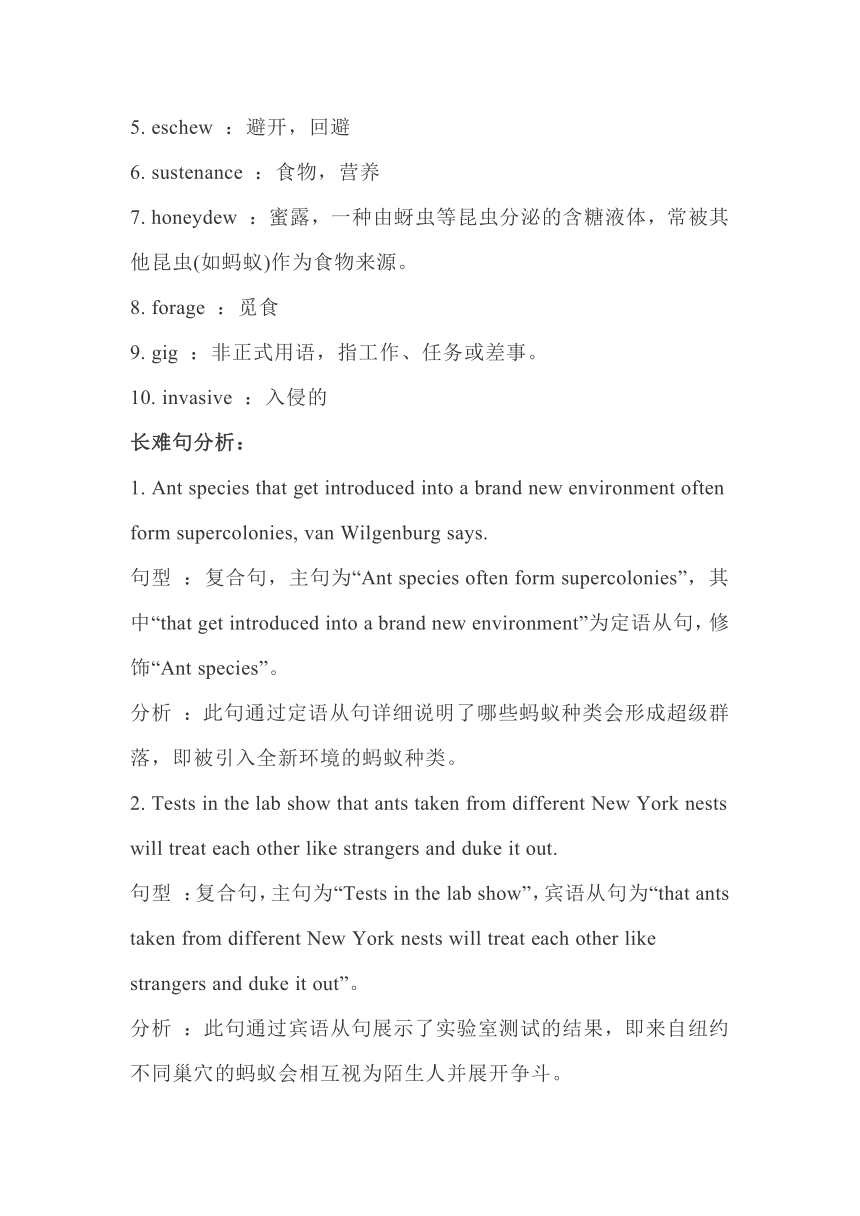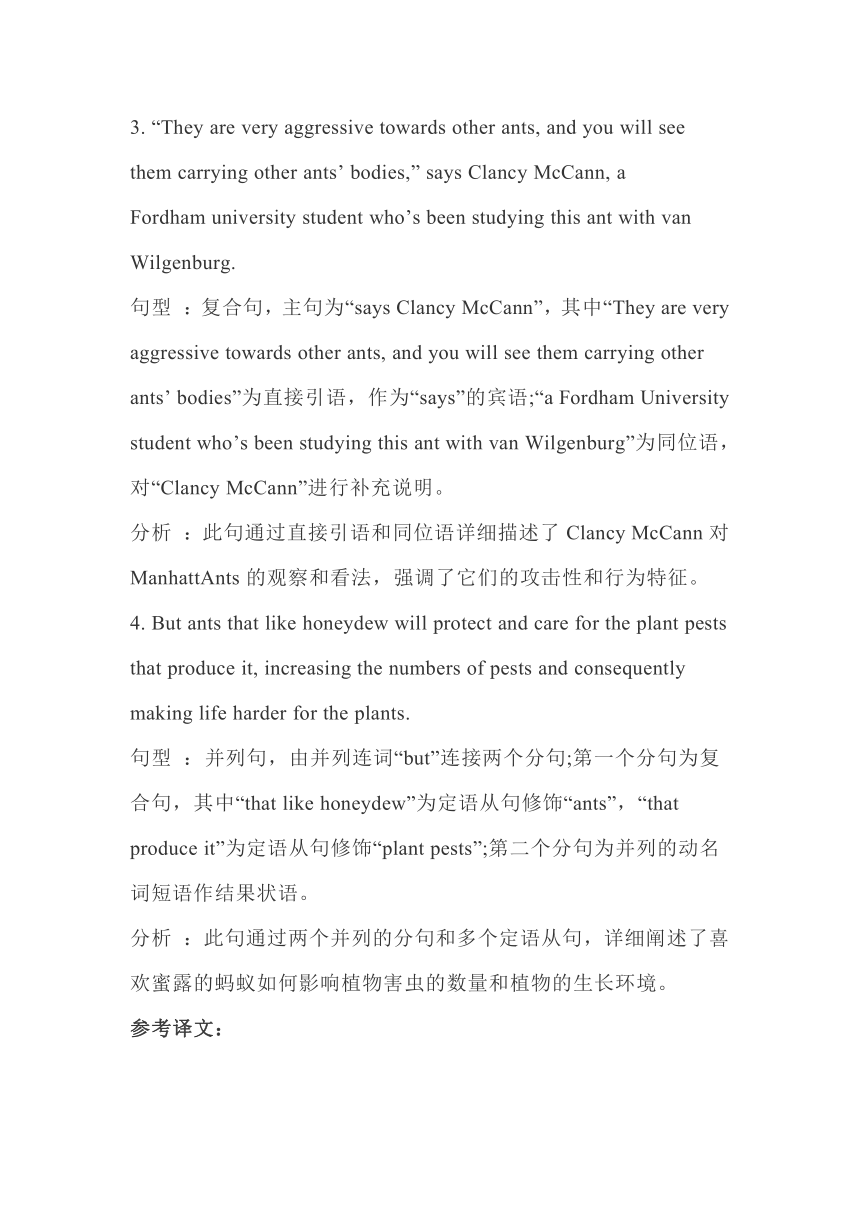2025届高考英语专项复习 阅读理解文章重点讲解讲义(词汇讲解 成分分析)
文档属性
| 名称 | 2025届高考英语专项复习 阅读理解文章重点讲解讲义(词汇讲解 成分分析) |  | |
| 格式 | docx | ||
| 文件大小 | 19.9KB | ||
| 资源类型 | 教案 | ||
| 版本资源 | 通用版 | ||
| 科目 | 英语 | ||
| 更新时间 | 2024-09-20 14:57:45 | ||
图片预览




文档简介
高考阅读理解文章重点讲解讲义(词汇讲解+成分分析)
1.曼哈顿蚂蚁
Ant species that get introduced into a brand new environment often form supercolonies, van Wilgenburg says. That means their nests all contain ants that are closely related and genetically similar, so the different nests don’t fight with each other.
That’s not the case with ManhattAnts.
Tests in the lab show that ants taken from different New York nests will treat each other like strangers and duke it out. Even neighboring nests that are physically close to each other, like in adjacent flower pots, can treat each other as dire enemies.
“They are very aggressive towards other ants, and you will see them carrying other ants’ bodies,” says Clancy McCann, a Fordham University student who’s been studying this ant with van Wilgenburg.
Izzie Kaplan, another Fordham student, says ManhattAnts — like many New Yorkers — are also speed walkers.
“They’re very fast, and that’s another reason why we’re super interested in them,” says Kaplan. Their speed may give them an advantage in the city as they compete with other species for resources.
In general, these ants eschew human food, although Kennett says her research shows that they will resort to whatever’s available in “really urban sidewalk habitats.”
Their main sustenance is honeydew, a kind of sugary poop excreted by aphids and scale insects.
The ants seem to be going up into street trees to forage for honeydew, says Kennett, and it may be that they’ve found a gig that’s not really being pursued by other ants in this city.
But ants that like honeydew will protect and care for the plant pests that produce it, increasing the numbers of pests and consequently making life harder for the plants. Invasive Argentine ants in California tend aphids in this way, for example, and have proven to be a real headache for citrus orchards there.
It’s “entirely possible” that, in the long term, ManhattAnts could have a negative effect on city trees, says Kennett, who says these ants seem to be foraging constantly, even at night. “I wish we could just see what they were doing all the time.”
重点词汇讲解:
1. supercolonies :超级群落
2. genetically similar :遗传上相似的
3. duke it out :非正式用语,意为“一决胜负。
4. dire enemies :死敌
5. eschew :避开,回避
6. sustenance :食物,营养
7. honeydew :蜜露,一种由蚜虫等昆虫分泌的含糖液体,常被其他昆虫(如蚂蚁)作为食物来源。
8. forage :觅食
9. gig :非正式用语,指工作、任务或差事。
10. invasive :入侵的
长难句分析:
1. Ant species that get introduced into a brand new environment often form supercolonies, van Wilgenburg says.
句型 :复合句,主句为“Ant species often form supercolonies”,其中“that get introduced into a brand new environment”为定语从句,修饰“Ant species”。
分析 :此句通过定语从句详细说明了哪些蚂蚁种类会形成超级群落,即被引入全新环境的蚂蚁种类。
2. Tests in the lab show that ants taken from different New York nests will treat each other like strangers and duke it out.
句型 :复合句,主句为“Tests in the lab show”,宾语从句为“that ants taken from different New York nests will treat each other like strangers and duke it out”。
分析 :此句通过宾语从句展示了实验室测试的结果,即来自纽约不同巢穴的蚂蚁会相互视为陌生人并展开争斗。
3. “They are very aggressive towards other ants, and you will see them carrying other ants’ bodies,” says Clancy McCann, a Fordham university student who’s been studying this ant with van Wilgenburg.
句型 :复合句,主句为“says Clancy McCann”,其中“They are very aggressive towards other ants, and you will see them carrying other ants’ bodies”为直接引语,作为“says”的宾语;“a Fordham University student who’s been studying this ant with van Wilgenburg”为同位语,对“Clancy McCann”进行补充说明。
分析 :此句通过直接引语和同位语详细描述了Clancy McCann对ManhattAnts的观察和看法,强调了它们的攻击性和行为特征。
4. But ants that like honeydew will protect and care for the plant pests that produce it, increasing the numbers of pests and consequently making life harder for the plants.
句型 :并列句,由并列连词“but”连接两个分句;第一个分句为复合句,其中“that like honeydew”为定语从句修饰“ants”,“that produce it”为定语从句修饰“plant pests”;第二个分句为并列的动名词短语作结果状语。
分析 :此句通过两个并列的分句和多个定语从句,详细阐述了喜欢蜜露的蚂蚁如何影响植物害虫的数量和植物的生长环境。
参考译文:
范·威尔根堡表示,被引入全新环境的蚂蚁种类往往会形成超级群落。这意味着它们的巢穴中都含有血缘相近、基因相似的蚂蚁,因此不同巢穴之间不会相互争斗。
但曼哈顿蚁却并非如此。
实验室测试显示,从不同纽约巢穴中取出的蚂蚁会将彼此视为陌生人并展开争斗。即使是物理上相邻的巢穴,比如相邻的花盆中的巢穴,也会将彼此视为死敌。
“它们对其他蚂蚁非常具有攻击性,你会看到它们搬运其他蚂蚁的尸体,”福特汉姆大学学生克兰西·麦坎恩说道,他与范·威尔根堡一同研究这种蚂蚁。
另一位福特汉姆大学学生伊齐·卡普兰表示,曼哈顿蚁——和许多纽约人一样——也是快步走者。
“它们非常快,这也是我们对它们极其感兴趣的原因之一,”卡普兰说道。在城市中,它们与其他物种争夺资源时,速度可能会为它们带来优势。
总的来说,这些蚂蚁会避开人类食物,尽管肯尼特表示,她的研究表明,在“真正的城市人行道栖息地”中,它们会寻找任何可用的食物。
它们的主要食物来源是蜜露,这是由蚜虫和介壳虫分泌的一种含糖排泄物。
肯尼特表示,这些蚂蚁似乎会爬上街道两旁的树木寻找蜜露,而且可能在这个城市中找到了其他蚂蚁并未真正追求的“工作”。
但是,喜欢蜜露的蚂蚁会保护和照料生产蜜露的植物害虫,从而增加害虫的数量,进而使植物的生活更加艰难。例如,加利福尼亚州的入侵性阿根廷蚂蚁就以这种方式照料蚜虫,并已证明是当地柑橘果园的一大难题。
肯尼特表示,“完全有可能”曼哈顿蚁在长期来看会对城市树木产生负面影响,她说这些蚂蚁似乎一直在觅食,甚至在夜间也是如此。“我真希望我们能一直看到它们在做什么。”
2.猫咪会悲伤
Researchers found that cats showed signs of grief, such as eating and playing less, after a fellow pet had died.
句子成分分析:主句是“Researchers found that...”,其中“that cats showed signs of grief...”是宾语从句,说明研究者的发现。
“such as eating and playing less”是插入语,用来举例说明grief的具体表现。“after a fellow pet had died”是时间状语从句,说明这些行为发生的时间点。
语法知识:宾语从句的使用,以及时间状语从句中过去完成时的使用(had died),表明动作发生在主句动作(found)之前。
If a human or another animal close to them dies, does a cat grieve the loss
That was the question a team of researchers from Oakland university in Michigan set out to answer when they surveyed hundreds of cat owners about their cat’s behavior after another cat or dog in the household passed away.
The data showed that cats exhibited behaviors associated with grief — such as eating and playing less — more often after the death of a fellow pet, suggesting they may in fact have been in mourning.
mourning 名词,意为“哀悼,服丧”。
“It made me a little more optimistic that they are forming attachments with each other,” said Jennifer Vonk, a professor of psychology at Oakland University, who co-authored the study, published in the journal Applied Animal Behaviour Science.
attachment 名词,意为“悲痛,忧伤”。
句子成分分析:“It made me a little more optimistic...”是主句,“that they are forming attachments with each other”是宾语从句,作为“optimistic”的原因。“said Jennifer Vonk...”是插入语,提供说话者的信息。“who co-authored the study...”是非限制性定语从句,修饰“Jennifer Vonk”。
语法知识:宾语从句、非限制性定语从句的使用,以及并列句(由逗号分隔的两个独立句子)的构成。
“It’s not that I want the cats to be sad,” Vonk went on, “[but] there is a part of us, I think, as humans that wants to think that if something happens to us our pets would miss us.”
When Animals Mourn: Seeing That Grief Is Not Uniquely HumanThough animals from elephants to horses to dogs have been shown to express signs of grief, less is known about the emotional life of the domesticated house cat. Vonk said she knew of only one other study on grief in domestic cats.
句子成分分析:简单句,主句是“Vonk said”,“she knew of only one other study on grief in domestic cats”是宾语从句,作为“said”的宾语。
语法知识:宾语从句的使用,以及“only”作为修饰词强调数量上的唯一性。
For their research, Vonk and her coauthor, Brittany Greene, surveyed 412 cat caregivers about how their feline companion acted after another pet in the house died.
feline 形容词,意为“猫的,猫科的”。
caregiver 名词,指“照顾者,护理人员”。
They found that, after the death of a fellow pet, cats on average sought more attention from their owners, spent more time alone, appeared to look for the deceased animal, ate less and slept more.
deceased 形容词, [正式]亡故的,已死的
参考译文:
研究人员发现,在同伴宠物去世后,猫咪会表现出悲伤的迹象,比如进食和玩耍的时间减少。
如果人类或其他与它们亲近的动物去世,猫咪是否会为失去它们而悲伤呢
密歇根州奥克兰大学的一个研究团队在调查了数百名猫主人关于家中另一只猫或狗去世后猫咪行为的情况后,试图回答这个问题。
数据显示,在同伴宠物去世后,猫咪更频繁地表现出与悲伤相关的行为——如进食和玩耍的时间减少——这表明它们可能确实在哀悼。
奥克兰大学心理学教授、该研究合著者詹妮弗·冯克表示:“这让我稍微乐观了一点,因为它们之间正在形成依恋关系。”这项研究发表在《应用动物行为科学》杂志上。
“我并不是想让猫咪感到悲伤,”冯克继续说道,“但我认为,作为人类,我们中的一部分人总是希望,如果我们遭遇不幸,我们的宠物会想念我们。”
动物哀悼:悲伤并非人类独有。虽然从大象到马再到狗,许多动物都已被证明会表现出悲伤的迹象,但人们对家猫的情感生活却知之甚少。冯克说,她只知道另一项关于家猫悲伤的研究。
为了进行研究,冯克和她的合著者布里塔尼·格林调查了412名猫主人,了解他们的猫咪在另一只宠物去世后是如何表现的。
他们发现,在同伴宠物去世后,猫咪通常会更多地寻求主人的关注,花更多时间独处,似乎还在寻找已去世的宠物,进食减少,睡眠时间增加。
1.曼哈顿蚂蚁
Ant species that get introduced into a brand new environment often form supercolonies, van Wilgenburg says. That means their nests all contain ants that are closely related and genetically similar, so the different nests don’t fight with each other.
That’s not the case with ManhattAnts.
Tests in the lab show that ants taken from different New York nests will treat each other like strangers and duke it out. Even neighboring nests that are physically close to each other, like in adjacent flower pots, can treat each other as dire enemies.
“They are very aggressive towards other ants, and you will see them carrying other ants’ bodies,” says Clancy McCann, a Fordham University student who’s been studying this ant with van Wilgenburg.
Izzie Kaplan, another Fordham student, says ManhattAnts — like many New Yorkers — are also speed walkers.
“They’re very fast, and that’s another reason why we’re super interested in them,” says Kaplan. Their speed may give them an advantage in the city as they compete with other species for resources.
In general, these ants eschew human food, although Kennett says her research shows that they will resort to whatever’s available in “really urban sidewalk habitats.”
Their main sustenance is honeydew, a kind of sugary poop excreted by aphids and scale insects.
The ants seem to be going up into street trees to forage for honeydew, says Kennett, and it may be that they’ve found a gig that’s not really being pursued by other ants in this city.
But ants that like honeydew will protect and care for the plant pests that produce it, increasing the numbers of pests and consequently making life harder for the plants. Invasive Argentine ants in California tend aphids in this way, for example, and have proven to be a real headache for citrus orchards there.
It’s “entirely possible” that, in the long term, ManhattAnts could have a negative effect on city trees, says Kennett, who says these ants seem to be foraging constantly, even at night. “I wish we could just see what they were doing all the time.”
重点词汇讲解:
1. supercolonies :超级群落
2. genetically similar :遗传上相似的
3. duke it out :非正式用语,意为“一决胜负。
4. dire enemies :死敌
5. eschew :避开,回避
6. sustenance :食物,营养
7. honeydew :蜜露,一种由蚜虫等昆虫分泌的含糖液体,常被其他昆虫(如蚂蚁)作为食物来源。
8. forage :觅食
9. gig :非正式用语,指工作、任务或差事。
10. invasive :入侵的
长难句分析:
1. Ant species that get introduced into a brand new environment often form supercolonies, van Wilgenburg says.
句型 :复合句,主句为“Ant species often form supercolonies”,其中“that get introduced into a brand new environment”为定语从句,修饰“Ant species”。
分析 :此句通过定语从句详细说明了哪些蚂蚁种类会形成超级群落,即被引入全新环境的蚂蚁种类。
2. Tests in the lab show that ants taken from different New York nests will treat each other like strangers and duke it out.
句型 :复合句,主句为“Tests in the lab show”,宾语从句为“that ants taken from different New York nests will treat each other like strangers and duke it out”。
分析 :此句通过宾语从句展示了实验室测试的结果,即来自纽约不同巢穴的蚂蚁会相互视为陌生人并展开争斗。
3. “They are very aggressive towards other ants, and you will see them carrying other ants’ bodies,” says Clancy McCann, a Fordham university student who’s been studying this ant with van Wilgenburg.
句型 :复合句,主句为“says Clancy McCann”,其中“They are very aggressive towards other ants, and you will see them carrying other ants’ bodies”为直接引语,作为“says”的宾语;“a Fordham University student who’s been studying this ant with van Wilgenburg”为同位语,对“Clancy McCann”进行补充说明。
分析 :此句通过直接引语和同位语详细描述了Clancy McCann对ManhattAnts的观察和看法,强调了它们的攻击性和行为特征。
4. But ants that like honeydew will protect and care for the plant pests that produce it, increasing the numbers of pests and consequently making life harder for the plants.
句型 :并列句,由并列连词“but”连接两个分句;第一个分句为复合句,其中“that like honeydew”为定语从句修饰“ants”,“that produce it”为定语从句修饰“plant pests”;第二个分句为并列的动名词短语作结果状语。
分析 :此句通过两个并列的分句和多个定语从句,详细阐述了喜欢蜜露的蚂蚁如何影响植物害虫的数量和植物的生长环境。
参考译文:
范·威尔根堡表示,被引入全新环境的蚂蚁种类往往会形成超级群落。这意味着它们的巢穴中都含有血缘相近、基因相似的蚂蚁,因此不同巢穴之间不会相互争斗。
但曼哈顿蚁却并非如此。
实验室测试显示,从不同纽约巢穴中取出的蚂蚁会将彼此视为陌生人并展开争斗。即使是物理上相邻的巢穴,比如相邻的花盆中的巢穴,也会将彼此视为死敌。
“它们对其他蚂蚁非常具有攻击性,你会看到它们搬运其他蚂蚁的尸体,”福特汉姆大学学生克兰西·麦坎恩说道,他与范·威尔根堡一同研究这种蚂蚁。
另一位福特汉姆大学学生伊齐·卡普兰表示,曼哈顿蚁——和许多纽约人一样——也是快步走者。
“它们非常快,这也是我们对它们极其感兴趣的原因之一,”卡普兰说道。在城市中,它们与其他物种争夺资源时,速度可能会为它们带来优势。
总的来说,这些蚂蚁会避开人类食物,尽管肯尼特表示,她的研究表明,在“真正的城市人行道栖息地”中,它们会寻找任何可用的食物。
它们的主要食物来源是蜜露,这是由蚜虫和介壳虫分泌的一种含糖排泄物。
肯尼特表示,这些蚂蚁似乎会爬上街道两旁的树木寻找蜜露,而且可能在这个城市中找到了其他蚂蚁并未真正追求的“工作”。
但是,喜欢蜜露的蚂蚁会保护和照料生产蜜露的植物害虫,从而增加害虫的数量,进而使植物的生活更加艰难。例如,加利福尼亚州的入侵性阿根廷蚂蚁就以这种方式照料蚜虫,并已证明是当地柑橘果园的一大难题。
肯尼特表示,“完全有可能”曼哈顿蚁在长期来看会对城市树木产生负面影响,她说这些蚂蚁似乎一直在觅食,甚至在夜间也是如此。“我真希望我们能一直看到它们在做什么。”
2.猫咪会悲伤
Researchers found that cats showed signs of grief, such as eating and playing less, after a fellow pet had died.
句子成分分析:主句是“Researchers found that...”,其中“that cats showed signs of grief...”是宾语从句,说明研究者的发现。
“such as eating and playing less”是插入语,用来举例说明grief的具体表现。“after a fellow pet had died”是时间状语从句,说明这些行为发生的时间点。
语法知识:宾语从句的使用,以及时间状语从句中过去完成时的使用(had died),表明动作发生在主句动作(found)之前。
If a human or another animal close to them dies, does a cat grieve the loss
That was the question a team of researchers from Oakland university in Michigan set out to answer when they surveyed hundreds of cat owners about their cat’s behavior after another cat or dog in the household passed away.
The data showed that cats exhibited behaviors associated with grief — such as eating and playing less — more often after the death of a fellow pet, suggesting they may in fact have been in mourning.
mourning 名词,意为“哀悼,服丧”。
“It made me a little more optimistic that they are forming attachments with each other,” said Jennifer Vonk, a professor of psychology at Oakland University, who co-authored the study, published in the journal Applied Animal Behaviour Science.
attachment 名词,意为“悲痛,忧伤”。
句子成分分析:“It made me a little more optimistic...”是主句,“that they are forming attachments with each other”是宾语从句,作为“optimistic”的原因。“said Jennifer Vonk...”是插入语,提供说话者的信息。“who co-authored the study...”是非限制性定语从句,修饰“Jennifer Vonk”。
语法知识:宾语从句、非限制性定语从句的使用,以及并列句(由逗号分隔的两个独立句子)的构成。
“It’s not that I want the cats to be sad,” Vonk went on, “[but] there is a part of us, I think, as humans that wants to think that if something happens to us our pets would miss us.”
When Animals Mourn: Seeing That Grief Is Not Uniquely HumanThough animals from elephants to horses to dogs have been shown to express signs of grief, less is known about the emotional life of the domesticated house cat. Vonk said she knew of only one other study on grief in domestic cats.
句子成分分析:简单句,主句是“Vonk said”,“she knew of only one other study on grief in domestic cats”是宾语从句,作为“said”的宾语。
语法知识:宾语从句的使用,以及“only”作为修饰词强调数量上的唯一性。
For their research, Vonk and her coauthor, Brittany Greene, surveyed 412 cat caregivers about how their feline companion acted after another pet in the house died.
feline 形容词,意为“猫的,猫科的”。
caregiver 名词,指“照顾者,护理人员”。
They found that, after the death of a fellow pet, cats on average sought more attention from their owners, spent more time alone, appeared to look for the deceased animal, ate less and slept more.
deceased 形容词, [正式]亡故的,已死的
参考译文:
研究人员发现,在同伴宠物去世后,猫咪会表现出悲伤的迹象,比如进食和玩耍的时间减少。
如果人类或其他与它们亲近的动物去世,猫咪是否会为失去它们而悲伤呢
密歇根州奥克兰大学的一个研究团队在调查了数百名猫主人关于家中另一只猫或狗去世后猫咪行为的情况后,试图回答这个问题。
数据显示,在同伴宠物去世后,猫咪更频繁地表现出与悲伤相关的行为——如进食和玩耍的时间减少——这表明它们可能确实在哀悼。
奥克兰大学心理学教授、该研究合著者詹妮弗·冯克表示:“这让我稍微乐观了一点,因为它们之间正在形成依恋关系。”这项研究发表在《应用动物行为科学》杂志上。
“我并不是想让猫咪感到悲伤,”冯克继续说道,“但我认为,作为人类,我们中的一部分人总是希望,如果我们遭遇不幸,我们的宠物会想念我们。”
动物哀悼:悲伤并非人类独有。虽然从大象到马再到狗,许多动物都已被证明会表现出悲伤的迹象,但人们对家猫的情感生活却知之甚少。冯克说,她只知道另一项关于家猫悲伤的研究。
为了进行研究,冯克和她的合著者布里塔尼·格林调查了412名猫主人,了解他们的猫咪在另一只宠物去世后是如何表现的。
他们发现,在同伴宠物去世后,猫咪通常会更多地寻求主人的关注,花更多时间独处,似乎还在寻找已去世的宠物,进食减少,睡眠时间增加。
同课章节目录
